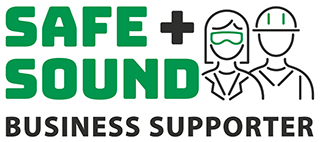“Safety should be a habit.” It’s an admirable idea, and it’s frequently stated as a goal. But what does it really mean? In this article we'll look at good safety habits in the workplace: what they are, why they’re important and how they come about, and providing strategies to build safe work habits on the job. You can also read Grainger's list of signs that safety habits have been established in your workplace to get concrete and actionable guidance on what to look for.
But let’s start with some basic questions.
What Is the Importance of Safety?
The importance of safety can be measured in dollars, though precise values are hard to calculate. Congress created OSHA in 1970 with the idea that safer working conditions would limit the substantial commercial burden of “lost production, wage loss, medical expenses, and disability compensation payments.”1
The commercial burden that OSHA intended to alleviate the cost of unsafe conditions falls on employers and on employees. It’s in the interest of both parties to work together to achieve a safer work environment. That’s why safety should be important for everyone from frontline workers up to CEOs and company owners, and why good safety habits are valuable across the board.
How Can You Practice Safety at Work?
Practicing safety is all about understanding hazards and mitigating risks. Looking from the top down, OSHA standards can guide safety managers who remedy problems and develop safe processes. And from the bottom up, good habits can help workers act safely, almost automatically. Ultimately, both approaches are critical.
The “top down” part is where safety professionals have the most power, creating systems and implementing engineering controls to mitigate hazards. But the “bottom up” part is where the rubber really hits the road. Established systems and procedures can’t do much good if people don’t understand and respect them.
Safety habits are an important way to gauge the health of what’s happening on the ground—the “bottom up” perspective. When you see the right habits, it’s a sign that people are following the rules all the time, rather than only doing the right thing when someone’s watching. Good safety practices begin with good habits.
Why Do Habits Matter?
First let’s look at what a habit really is. A habit is a decision you never even think about; it’s a choice you’ve already made.4 You don’t need to decide whether or not to brush your teeth before bed each night, for example—you decided that long ago. When workplace safety is a habit, it follows the same pattern: basic everyday precautions, like wearing PPE, become automatic.
You can also think of habits as mental shortcuts. They allow people to navigate the constant flow of everyday life and all the small choices that are part of it, while conserving mental energy for the most important decisions.
That’s why it’s so critical to promote good safety habits. Researchers have found that habits account for as much as 40% of human behavior.3 Habits guide our most routine, unthinking behaviors, and good habits will guide them in good directions.
How Do You Encourage Good Safety Habits in the Workplace?
You know an action has become a habit when any break from routine just feels wrong. Children need to be reminded to wear a seatbelt, but once the behavior becomes habitual, riding unbuckled just feels “wrong.” When the habit is entrenched, we immediately notice any lapse—if the car is moving and you don’t feel the seatbelt pressing against your lap, its absence serves as a reminder to buckle up. The development of safe habits in the workplace can follow a similar progression.
Repetition is the key to building a strong habit. Research shows that a new habit takes at least 21 days to take hold, but the average worker will require ten weeks of conscious repetition before the action becomes automatic, and the most forgetful members of the team will take almost twice as long.3
Consistency is also vital for habit formation. In the early stages of developing a habit, even momentary lapses can erode the behavior—if a worker ducks onto the production floor to run an errand without a hardhat “just this once,” then skipping PPE becomes a possibility in their mind. To build firm habits, you need to enforce adherence without exception, especially in the early days of development.
The way you reinforce the habit matters, too. Building a habit requires constant reminders in the early stages. A positive, proactive approach will be more effective than reactive, negative attitude. If you’re cracking down on lapses after the fact, you’re already too late. Consistency—not correction—turns the action into a habit.3
So instead of focusing on punishment for workers who forget to follow procedure, take a moment to proactively reinforce positive behavior as it’s happening. A timely nudge can preemptively ensure compliance, doing far more to form the habit than any amount of post-lapse punishment.
How Can You Keep Good Habits Going?
Maintaining a system of cues and rewards after the formation period will help keep the habit firmly entrenched and help spread it among new hires. The same proactive approach that seeded the habit will help sustain it, and an incentive system that rewards consistency will complete the feedback loop that maintains the ingrained behavior. Celebrating milestones will encourage the workforce to keep the streak going.3
Forming a safety habit is hard work: it requires commitment and follow through. But if your workforce is automatically adhering to the daily routine, they will be able to pay more attention to emerging risks and unplanned developments. Making a habit of routine safety can yield greater situational awareness throughout the workday.
 Grainger is a proud supporter of Safe + Sound, OSHA’s year-round campaign to encourage workplace safety and health programs.
Grainger is a proud supporter of Safe + Sound, OSHA’s year-round campaign to encourage workplace safety and health programs.OSHA also invites organizations to share and celebrate their successes with Safe + Sound Week each August. Visit OSHA’s website for activity ideas and more.
References:
2. The Power of Habit: Why We Do What We Do in Life and Business, Charles Duhigg, Random House (2012)
3. Page-Bottorff, T. (2016). The Habit of Safety: Forming, Changing and Reinforcing Key Safety Behaviors. Professional Safety, (February 2016), 42-43.
4. Hill, R. H. (2018). Make safety a habit! Journal of Chemical Health and Safety, 25(2).
CenterPoint Group provides group purchasing discounts to key suppliers such as Office Depot, Staples, National Car Rental, W.W. Grainger, Verizon Wireless and more.





The information contained in this article is intended for general information purposes only and is based on information available as of the initial date of publication. No representation is made that the information or references are complete or remain current. This article is not a substitute for review of current applicable government regulations, industry standards, or other standards specific to your business and/or activities and should not be construed as legal advice or opinion. Readers with specific questions should refer to the applicable standards or consult with an attorney.



Leave a Reply
Comment policy: We love comments and appreciate the time that readers spend to share ideas and give feedback. However, all comments are manually moderated and those deemed to be spam or solely promotional will be deleted.